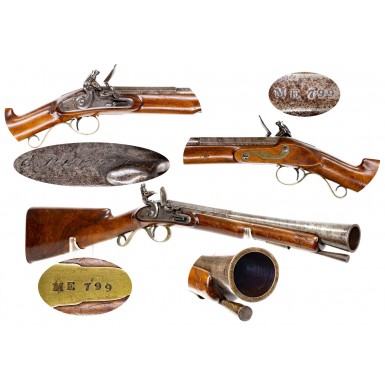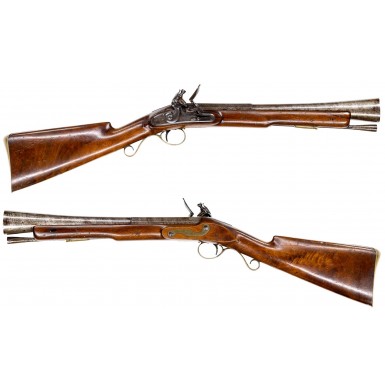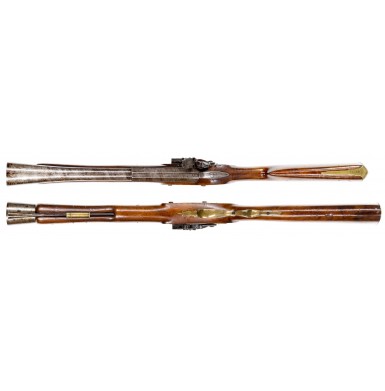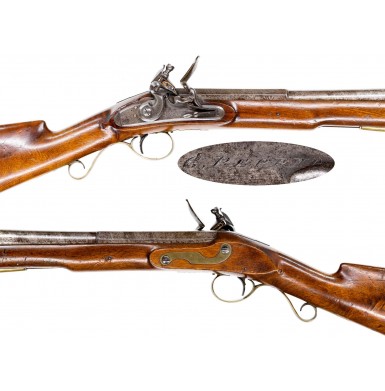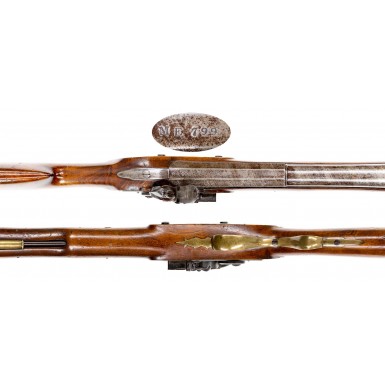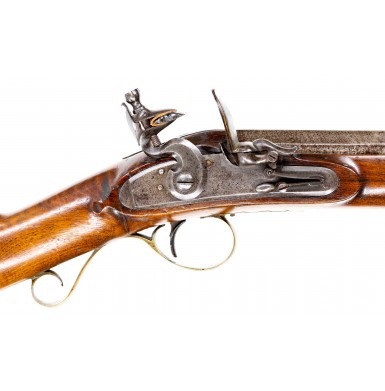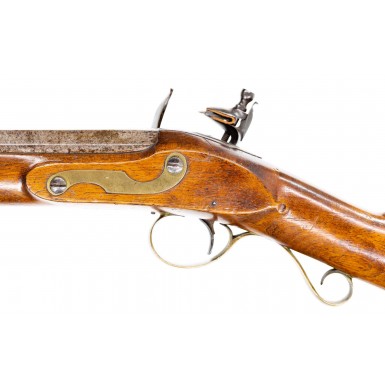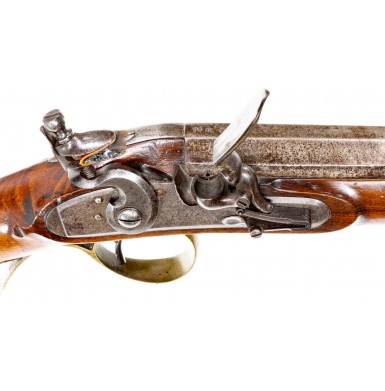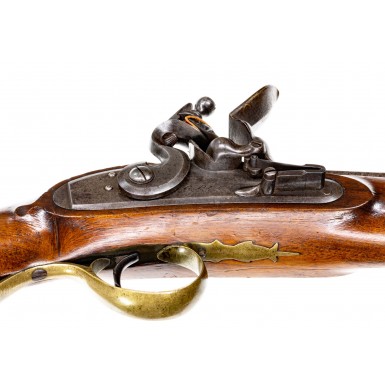Dublin Made Flintlock Blunderbuss by George Pepper with Irish Registration Act of 1843 County Meath Markings
- Product Code: FLA-3821-SOLD
- Availability: Out Of Stock
-
$1.00
The word blunderbuss often suggests the somewhat exaggerated flared muzzle firearms found in romanticized paintings of the Pilgrims at the Frist Thanksgiving. More recently they have appeared in the embellished images of Pilgrims (and even turkeys) armed with these somewhat cartoonish weapons, not to mention the irascible Elmer Fudd in wondering if it is “rabbit season” or “duck season”. In reality, the “blunderbuss” appears to be a weapon that originated in the Low Countries (Netherlands) around the middle of the 17th century, and which spread rather quickly to England, where it became a popular weapon for self-defense and protection of one’s home, property and mode of transportation. By definition, a blunderbuss is a short barreled long arm with a flared muzzle that was designed to spray its shot in a relatively wide pattern at close range, making it particularly effective for deterring would be assailants that were in close proximity, and relying on a minimum of skill or aiming to be relatively effective. The term “blunderbuss” is the anglicized version of the Dutch / German term “Donner Busse” or “Donder Busche” meaning “Thunder Pipe” or “Thunder Gun”. These guns were, for all practical purposes, the first “tactical shotguns” and had minimal use for sporting applications as their short barrels and wide, flared muzzles were not intended for effective use much beyond 20 to 30 yards. The form evolved rather quickly in England, where the blunderbuss would remain a staple defensive weapon of the coachman for nearly a century and half. Only the advent of the percussion era and the nearly simultaneous spread of early railroads brought the day of the coaching gun to an end in England.
For much of the period during which the blunderbuss was produced in Great Britain the basic form was a flintlock muzzleloader with a bore between about .60” and 1” and a widely flared muzzle. Early guns tended to have iron barrels, but by the early 1700s most of the guns were made with brass barrels, with iron only coming back into general use in the first quarter of the 1800s, during the waning days of the blunderbuss. Early guns tended to be somewhat clunky and bulky, with simple furniture and dog lock batteries; functionality being the primary concern over aesthetics. During the first quarter of the 1700s, the form matured, and more graceful lines and ornamentation became typical. The blunderbuss reached its aesthetic apex during the latter half of the 18th century, when engraved locks and furniture became more common and enhancements like triggerguard finials and wrist escutcheon plates became common. Raised carved aprons around the barrel tang became common embellishments as well. Barrels were often multi-stage during the 18th century, with octagon-to-round forms appearing and the use of baluster turned “wedding bands” between various the stages of the barrels. A new form of blunderbuss started to emerge during the mid-1700s, the “coaching musketoon” or “coaching carbine”. These guns tended to have less profoundly flared barrels and were intended to give a longer effective range to the shot than the more radically flared muzzle of the traditional blunderbuss. I some cases the barrels were longer than the typical blunderbuss as well, again in an attempt to increase the effective range of the weapon. During this period canon shaped muzzles became popular on these “carbines” and the addition of spring deployed “snap bayonets” became popular as well. A miniaturized version of the coaching carbine (sometimes referred to as a “bedroom blunderbuss” by collectors) was also popularized during the period as an easier to handle, more compact weapon (along the lines of a sawed-off shotgun) that could be easily concealed by an overcoat but could be wielded handily within the confines of a room or even the interior of a coach or carriage. These weapons could be as small as about two foot in length with barrels of only about ten inches.
The need for such weapons was due to the very danger inherent in travel across Great Britain during the latter 17th and most of the 18th century. Roads were limited, of poor quality, and rarely maintained, with the exception of privately owned coach roads and turnpikes that required a traveler to pay a toll for their use. Footpads and Highwaymen abounded, and travelers were often accosted and robbed while travelling in the countryside. It was for that reason that people rarely traveled alone and even the mail coaches and stagecoaches of the period usually relied upon a crew of at least two; a driver and guard. The guard often doubled as the baggage handler and had to help free the coach when it was stuck or to repair damage that was often caused by the rough roads. These men inevitably relied upon some form of blunderbuss, or a pair if available, as their primary weapon for defending the coach, its passengers and any freight or mail it might be carrying.
Offered here is a very nice example of a fairly scarce Irish-made Blunderbuss from the 2nd quarter of the 19th century. The gun was made towards the end of this pattern of firearm’s period of use and bears additional marks that not only help to tell its story, but that show that the flintlock ignition system remained in use after it was technologically obsolete.
The gun was produced by George Pepper of Dublin and is signed G. Pepper on the lock plate. Pepper worked circa 1828-1836. Initially he was located at Upper Abbey Street and moved to 25 Chapel Street circa 1835. Pepper was likely related to an earlier Dublin gunmaker also named George Pepper who worked circa 1750-1800. The first Pepper was known for producing particularly high-quality flintlock holster pistols during the latter half of the 18th century. Other than the maker’s signature, engraved on the lock, the only other external markings are the alphanumeric mark ME 799 stamped on the top of the buttplate and on the top of the breech. This is an Irish firearms registration mark, required to be applied to comply with the Registration Act of 1843. The act sought to not only register but to regulate the ownership, carry and use of firearms in Ireland, and built upon a history of arms control in Ireland that dated back to the mid-18th century. From that time, it had been illegal for Roman Catholics in Ireland to own or “carry” firearms, with that right being reserved for Protestants. In reading some of the Parliamentary Debate about the bill, it becomes clear that the real purpose of the act was not only continue the restriction of Catholics in the ownership of arms, but to make it easier to prove that any arm that they were in possession of were illegal, either because they were not registered or because they were registered, and the registration markings would indicate the arms had been stolen from a Protestant. Clearly Parliament was terrified of the suppressed Catholic peasantry acquiring arms and revolting against their Protestant overlords. The Act was fairly short-lived, running from only 1843 to 1846, but was another indication that the British government intended to do everything it its power to keep Irish Catholics from having the ability to take up arms in the defense of their rights, a lesson Great Britain had learned from its American colonies less than seventy years earlier.
The ME 799 marking indicates that this blunderbuss was the 799th gun registered in County Meath during the period of the registration act. County Meath is located on the east coast of central Ireland, immediately above County Dublin. Meath was a historically Roman Catholic county and to this day in excess of 80% of the county’s the residents remain Roman Catholic. According to the Official House of Commons Returns, dated 8 May 1846 a total of 4,781 firearms were registered in the seven districts of County Meath under the Registration Act. These included 2,398 Guns, 1,962 Pistols, 417 Blunderbusses and 4 Cannons. From these returns it is clear that of small arms, the blunderbuss was the least common in use in this county and represented less than 9% of all arms registered under the act. It is also clear that although the percussion system had been in general use on many sporting arms for roughly a decade when the Registration Act was passed, that this flintlock blunderbuss was still in use. It is worth noting that despite the attempt to suppress the Irish peasantry and keep them disarmed, the Young Irelander Rebellion, an Irish nationalist uprising, occurred in 1848 only two years after the repeal of the Registration Act. Over the next seventy years the rebellions and uprisings would continue, with different names and under varied leadership, culminating in the 1916 Easter Rising and then the Irish Republican War of Independence from roughly 1917 through 1922. This registered blunderbuss is a window into that world of Irish Nationalism and sectional civil war.
This George Pepper blunderbuss is a classic example of a 19th century gun produced along the lines of the classic from with a nod to utilitarian design. The gun is mid-sized, measuring 31 ½” in overall length with a 16 3/8” barrel. The barrel is of the classic form with a two-stage octagon to round profile. It has a 5 ¾” octagonal section that transitions to the flared round section with a baluster turned ring. The bore is nominally about .75 caliber and flares to just under 1 ¾” at the muzzle. The barrel is made of “twist steel” with the twist pattern still readily apparent. The barrel is secured to the full-length walnut stock with pins and via a single screw through the breech plug tang. The flat, beveled lock has a rounded and stepped tail and measures 5 ¼” in length. The lock has a rounded and fenced, integral iron waterproof pan and is equipped with a roller frizzen. The lock has a flat, beveled swan-neck cock. The furniture is of brass and rather simple with buttplate, flat S-shaped side plate, single ramrod pipe and scroll shaped triggerguard. The stock is of walnut and of simple, utilitarian design with a pronounced swell in the forend near the muzzle, with the only nod to decoration being a simple carved apron at the rear of the lock. The ramrod is an equally utilitarian trumpet shaped iron affair with not threads at the end. The rod is the correct size, shape and form but may be a period of use replacement.
The gun remains in NEAR FINE condition. The barrel was likely originally browned to enhance the twisted steel pattern and traces of that coloration are found in the grain of the twisted barrel. The barrel is mostly a dull smoky gray color with some traces of brown and scattered patches of surface oxidation and age discoloration. The metal is mostly smooth with some scattered patches of lightly oxidized surface roughness and some scattered areas of light pinpricking and some smaller patches of light pitting. This is most obvious around the breech and at the muzzle area of the gun. The lock was originally color casehardened and retains some minute, muted traces of color in the protected areas with a mostly mottled gray patina that hints at the original coloration. The lock remains in its original flintlock configuration and has never been altered. Even the top jaw and top jaw screw appear to be original to the cock and lock. The lock remains crisp and fully functional in all ways with both the mainspring and frizzen springs retaining strong tension and the roller frizzen operating smoothly. The touchhole is tight and unmolested with some scattered light pitting around its face and showing only some minor erosion. The lock retains the crisply engraved G Pepper marking, with the last letter partially obscured by the lobe final of the frizzen spring. The brass furniture has a mellow golden patina and is very attractive. The stock of the gun remains crisp as well, and is full-length and free of any breaks, cracks, or repairs. The stock retains much of its original finish and retains sharp edges with no indication of having ever been sanded. The wood shows some scattered light handling marks and minor bumps, and dings as would be expected, but shows no indications of having ever been mishandled or abused in any way.
Overall, this is a very nice example of a rather scarce Irish made and Irish registered 19th century blunderbuss that was made in Dublin and was used in County Meath. The gun has a wonderful form and lovely proportions and remains in its original flintlock configuration. Based on the registration numbers, it is clear that blunderbusses were uncommon in County Meath during the 1840s, representing less than 10% of the firearms then in circulation. This would be a wonderful addition to any collection of Irish arms, blunderbusses or any collection that centers on the arms of Irish Nationalism and the various uprisings that eventually lead to home rule and the independence of Northern Ireland. This would be a great addition to a collection that might include a Fenian Brotherhood marked Needham Conversion Rifle Musket and a German 1871 Rifle from the Easter Rising. This gun was previously part of the famous VanMale collection of Arms & Armor and was part of the collection of the Frazier History Museum for nearly two decades.
Provenance: ex-VanMale Collection, ex-Frazier History Museum Collection
SOLD
Tags: Dublin, Made, Flintlock, Blunderbuss, by, George, Pepper, with, Irish, Registration, Act, of, 1843, County, Meath, Markings

